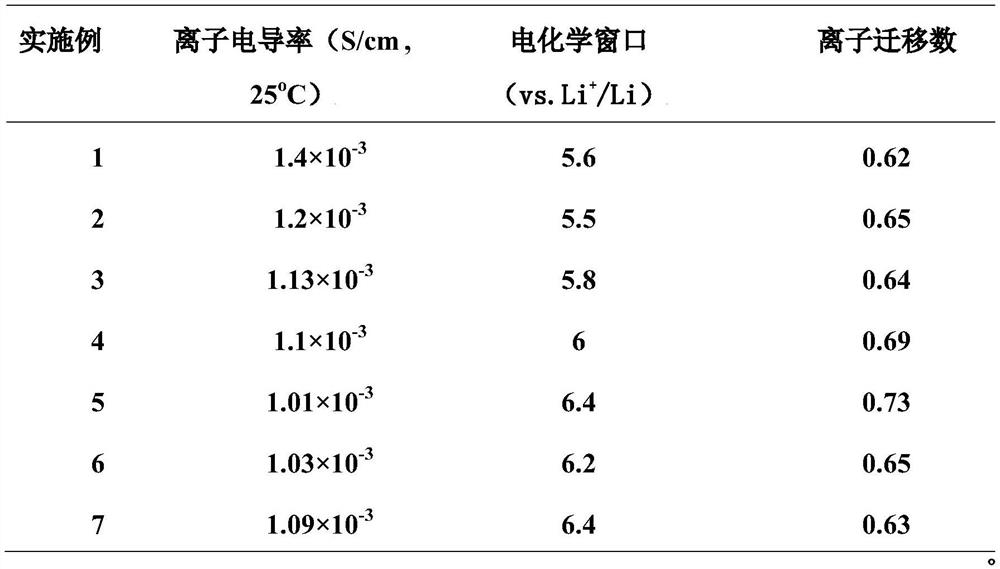Preparation and application of organic-inorganic composite solid electrolyte
A solid electrolyte, inorganic composite technology, used in circuits, electrical components, secondary batteries, etc., can solve the problems of inability to meet the use of high-voltage cathode materials, poor cycle performance, low ionic conductivity, etc., and achieve excellent ion transport capacity and thermal conductivity. Effects of stable performance, improved charge and discharge performance, and high ionic conductivity
- Summary
- Abstract
- Description
- Claims
- Application Information
AI Technical Summary
Problems solved by technology
Method used
Image
Examples
Embodiment 1
[0029] Mix and stir ethylene ethylene carbonate (VEC) and lithium bistrifluoromethanesulfonimide (LiTFSI) in a ratio of 7.69:2.31 to obtain solution A, and stir at room temperature to completely dissolve; according to the quality of the solution, add solution A Azobisisobutyronitrile with a mass of 0.5-1‰ was uniformly stirred for 2h. Then hydroxyl-rich functionalized nanosilica (SiO 2): (Solution A)=0.5:9.5 ratio, stir at room temperature for 1h, then ultrasonic for 2h, continue to stir for 4h, make it fully combined to produce intermolecular interaction, on the polytetrafluoroethylene mold, use whatman glass fiber membrane For the porous support framework, the uniformly stirred mixture was scraped onto both sides of the whatman film; heated in a vacuum drying oven at 80°C for 10 hours to cure to form a film.
Embodiment 2
[0031] Mix ethylene ethylene carbonate and lithium bistrifluoromethanesulfonimide (LiTFSI) in a ratio of 7.69:2.31 with stirring B, add N-methylpyrrolidone (NMP) with a mass of 50% of the mixture and stir at room temperature to completely dissolve it ; According to the quality of solution B, add azobisisobutyronitrile with a mass of 0.5-1‰ and stir evenly for 2h. Then add functionalized nano-alumina: (solution B) = 0.5:9.5 ratio to mix, stir for 1h, then sonicate for 2h, continue to stir for 4h, make it fully react to generate intermolecular interaction, in the polytetrafluoroethylene mold Using whatman glass fiber membrane as the porous support skeleton, the evenly stirred mixture was scraped onto both sides of the whatman membrane; heated in a vacuum drying oven at 80°C for 10 hours to cure to form a membrane.
Embodiment 3
[0033] Dissolve ethylene ethylene carbonate and lithium bistrifluoromethanesulfonimide (LiTFSI) in a ratio of 7.69:2.31, mix and stir C, add a certain amount of N-methylpyrrolidone (NMP) and stir at room temperature to make it completely dissolved; According to the quality of solution C, azobisisobutyronitrile with a mass of 0.5-1‰ was added and stirred uniformly for 2h. Then the nanosized (solid electrolyte Li 6.4 Ga 0.2 La 3 Zr 2 O 12 ):(Solution C)=0.5:9.5 ratio, stir for 1h, then sonicate for 2h, continue to stir for 4h, make it fully react to produce intermolecular interaction, on the polytetrafluoroethylene mold, with whatman membrane as porous support The skeleton, the evenly stirred mixture was scraped onto both sides of the whatman film; heated in a vacuum drying oven at 80°C for 10 hours to cure to form a film.
PUM
| Property | Measurement | Unit |
|---|---|---|
| thickness | aaaaa | aaaaa |
| electrical conductivity | aaaaa | aaaaa |
| electrical conductivity | aaaaa | aaaaa |
Abstract
Description
Claims
Application Information
 Login to View More
Login to View More - R&D
- Intellectual Property
- Life Sciences
- Materials
- Tech Scout
- Unparalleled Data Quality
- Higher Quality Content
- 60% Fewer Hallucinations
Browse by: Latest US Patents, China's latest patents, Technical Efficacy Thesaurus, Application Domain, Technology Topic, Popular Technical Reports.
© 2025 PatSnap. All rights reserved.Legal|Privacy policy|Modern Slavery Act Transparency Statement|Sitemap|About US| Contact US: help@patsnap.com

